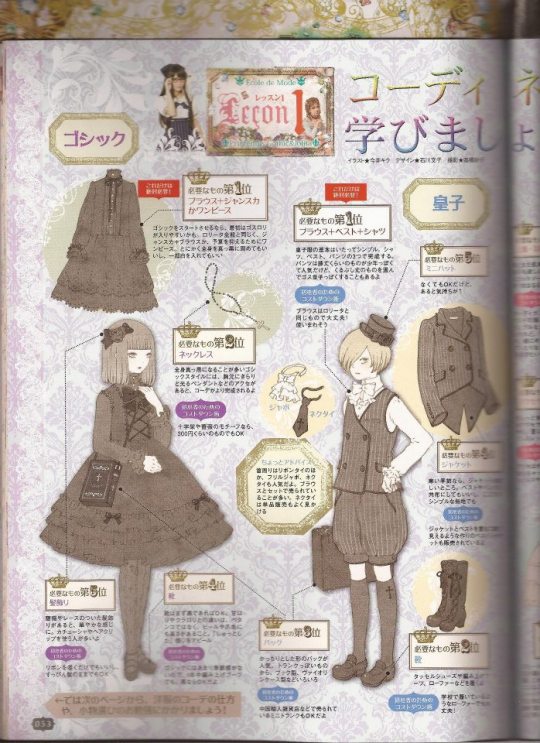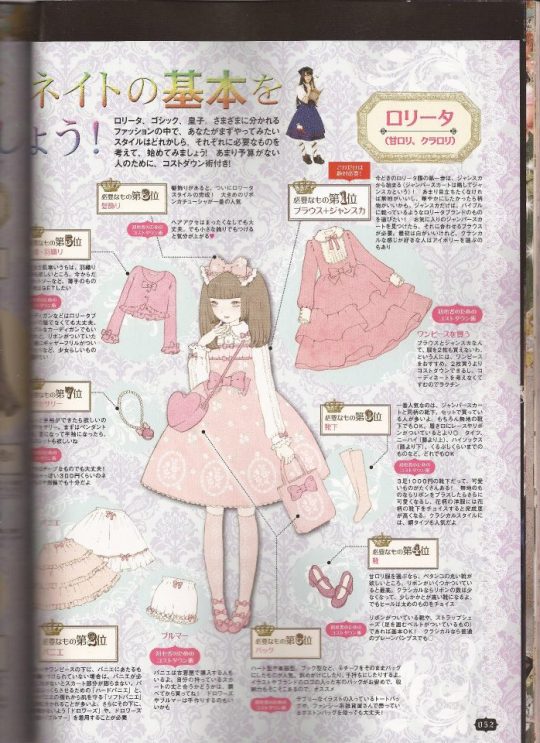This is what happens when some Frill lover tries to understand engrish while loosing all faith in humanity
Don't wanna be here? Send us removal request.
Photo



Gothic & Lolita Bible vol. 47
2K notes
·
View notes
Photo






magazine - eternita
Billed as a magazine for adult otomes (大人乙女), Eternita covers otome and lolita fashion. The magazine should appeal to readers of CUTiE magazine (which is no longer in circulation) and Gothic Lolita Bible. Also, like Larme magazine, Eternita’s first issue has an otherworldly and “cultured” vibe (see this post on Larme magazine’s aesthetic to learn more about the possible significance of this trend).
As Eternita is a new magazine, please support the magazine by purchasing a physical copy if it interests you!
820 notes
·
View notes
Photo

(Almost late) Inktober 26 - Squeak A sweet loli entering a gloomy old school gothic wardrobe…
808 notes
·
View notes
Photo







Mana’s guest appearance with Schwarz Stein.
908 notes
·
View notes
Text
Introduction
So what is EGL, exactly, and Lolita, more broadly? (the grammar is such a big issue with this fella)
Mana is, for the most part, a gothic lolita. A large section of his clothing line, Moi Même Moitié, is devoted to the gothic lolita style, while the other bit is "elegant gothic aristocrat" (i think). (Great way to start, they don’t even introduce the style properly, not even explain Mana’s long history wit lolita fashion and they don’t have any idea about the brand) A perfect example of the style would be his costume (coord) with the floofy little skirt from the live concert DVD "Bara ni Idorareta Akui to Higeki no Makuake". It's been around for quite some time according to my advisor, but I don't believe it's gotten much attention until recently. (giving opinions into a informative article without knowing shit about the subject matter is okay? no) There are more lolitas than ever now, and I can't help but think it had something to do with Mana. In fact there is now a randomly (four times a year is not randomly) published four-volume magazine called the Gothic & Lolita Bible (I'll be calling it "The Glub") (GLUB) devoted entirely to gothic lolita-ism, that always has a large section dedicated to him and his clothing brand. (lolitaism: the philosophycal movement fonded by mana-sama in which in order to be superior you must have all the burando) It also features drawings by Mihara Mitsukazu* and has recently begun to use other Jrock celebrities to promote the different brands of clothing. Some of the most notable are Kana, Dada, Miyavi, and the Pink Psycho. If you're interested, it's about $16.00 or so at www.fujisan.com.
I guess it's a little hard to define a lolita, (this entire section should have been first). since there is such a wide variety of styles and extremes (you know, the far left and far right are present in the lolita fashion) in the clothing. They range from punk to dolly dresses and everything in between, including punky dolly dresses (this exact phrase made me open a bottle of Rum). Originally, Lolita was the name of a young girl in a book by Vladimir Nabokov . The book is about an older man who falls in love with her, and this is where the term "lolita complex" came from (Rorikon in Japanese). (this is a very akward way to try to distinguish the lolicon from lolita fashion, it feels like the writter tried to just include all the stuff they knew while they were thinking about it.) A lolita complex is used to refer to and older person who has an interest in children. The Japanese took the concept and, as they do with seemingly everything, related it to anime and manga. The lolita (loli, not lolita, even in the old school times they tried to separate the two concepts by calling the sexual lolicon and the fashion gosurori), a cute, innocent, very well endowed little shojou that usually wears skimpy clothes or schoolgirl salior suits, was named for this. In gothic lolita terms it means frills, lace, ribbons, knee undershoes, and poofy skirts in pastel and flowered cloth. (i think they just mixed all the styles alltogether. Pastel colors are from sweet, flower patterns are mostly classic, this is not a old-school vs modern thing even.) Rather than "lolita" in the original sense, its definition is closer to a western princess/french doll look. It really does look a lot like something you might find a porcelain doll wearing. (well, porcelain dolls are usually collected from some decades or centuries ago. If you have ever had some kind of doll you have noticed that people usually dress the dolls with clothing that mimics the fashion of the time, same goes with old french dolls. Lolitas clothes are not doll-like, they have past times inspiration. I know this is a nitpick but i also want to inform people a bit) Being such, it doesn't mean that anyone who likes the lolita style is a pervert. Mana is very careful to inform people that he doesn't have a rorikon. (oh boy, don’t even get started into ddlg and sissies here please) Recently, according to a Hanumaru Cafe special, it's become popular to be either an angel or a demon gothic lolita. As far as I can tell, it just depends on whether the lolita wants to wear black or white. (unrelated anecdote for the win) For more information, see the guid up top.
The gothic part of the lolita goth is, well, gothic (no shit Sherlock). Vampires, black, heavy make-up, middle age European clothes, whatever else a goth is. (The writer does not only have an idea who mana is or lolita is... they don’t even know what gothic is, wow) The two styles combine in different ways. You can get complete doll dresses and then find something gothic at a different store, or something with punkish shredded cloth and bondage undertones. (you guys know how some not-so-short time ago i commented about opening a bottle of Rum? Yes? This two phrases decreased my IQ to the half i had remaining after the drink. I don’t know how this person looked at this and said: “this is totally alright, i absolutely know what the fuck i am talking about. ) Sometimes they're blatantly bondage, I suppose. They also seem to like silly hats and parasols, and were probably into humongous platform shoes until the government banned them because people couldn't drive well in them and were getting into car accidents. (wait what?) Or something like that. Now some of the more bold loli's may carry a doll around. But, as you can see, each brand has its own unique style. Or use to. It is my opinion that they've all been meshing together and there really isn't much variation in any of it; they've been conforming. The prices are outrageous by american standards, and still slightly high by Japanese standards. Maybe $150-$450 for a dress, $125 for a skirt.. ( except that the second hand market and the handmade comm have been a thing since long time ago, handmade being practically the origin of the fashion) Anyhow, back to the glub. I suppose I would consider it a sort of bible, although I've only been to Japan twice so I don't know much about what else is out there. (Welp, there is gosurori, kera and zipper) The interesting thing about it is that it not only provides clothing guides and celebrity interviews, but also a long list of "gothic" products (oh, you mean like almost all the magazines?). They like puppets, angels, and vampires a lot. They're also really into Tim Burton and Edward Gorey*, who they call Edward Golly in the typical Japanese fashion*. I'll add a section on him later since I firmly believe that everyone should at least read "The Dwindling Party" before they expire ^^. That aside, there is always a poem or article of some sort somewhere in the magazine to introduce the whole ideology behind the magazine and clothes. Yup, there's an actual ideology behind it. Surprised, ne? (Holy mother goose, i really do regret to joke that lolitaism was a movement based on a brand hierarchy. This person must think that lolita has its own political party or something like that. What do they promise? That AP will start to do dresses that are wearable to people with human anatomy? or that VW or Excentric will come back from the dead?) I don't know if everyone really follows it though. Last time they had a street shot of a lolita who probably had no idea what Jrock was; she liked Ayumi for goodness sake. She was probably wearing the dress because it was "kawaii" (cute), a word that the silly shojou pop-culture followers seem to idolize, but which is only fine when used in moderation. Truthfully, they are cute ^^ but you have to be prepared when you first see one or it's a little creepy. (Judging people from the street snaps from their tastes and also mixing weeb culture with japanese vocabulary is now a thing)
They refer to the style as "youfuku", or western clothes. But they're really not, since very few westerners ever wear anything like that, and if they do they've gotten it from Japan. (I did a quick google search and found that the therm is used for whatever garment that doesn’t follow the japanese traditional clothing line; things like jeans, blouses, jackets.. all of them enter in the category. So, yeah, this is wrong) The Japanese tend to blame wierd things on the west, even if they're almost completely unrelated. (unrelated to the subject) The words they've borrowed from English are interesting because they show the same thing.
Welp guys, this is all for this text. Just gotta say that this persons writting is atrocious even for me (being english my third language. I hope some of you survived to the experience or didn`t give up into psychoactive substances.
Source
Stay classy
#lolita#lolita fashion#commentary#lolita fashion 101#gothic lolita#egl#ega#egl community#lolita humor#mana-sama
1 note
·
View note
